Table of Contents
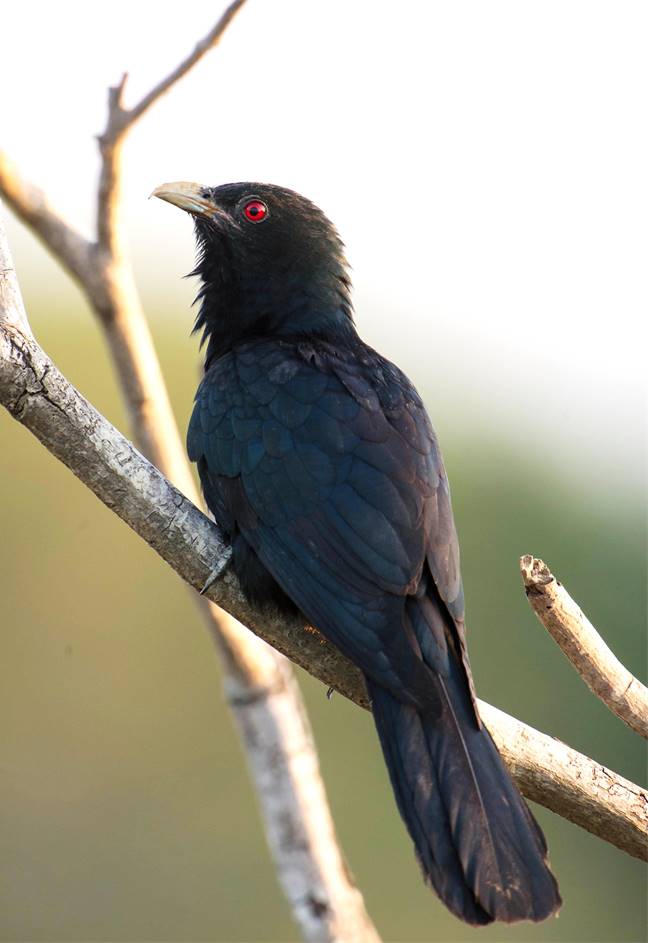 |
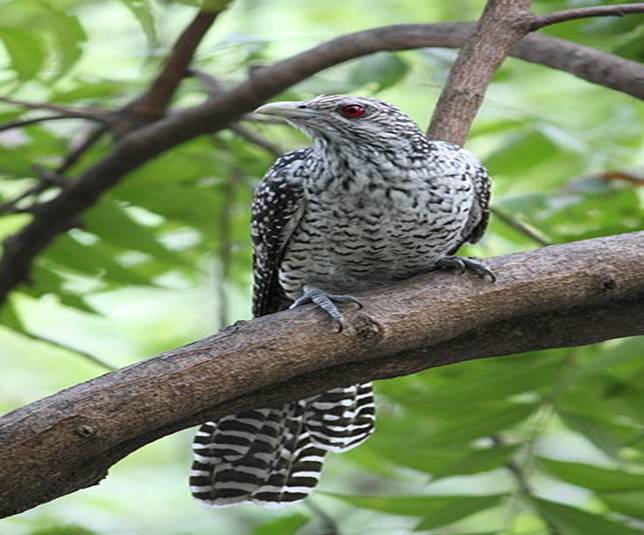 |
| Figure 1: Male Eudynamys scolopaceus. Source: Jason Thompson, 2013 (Wikimedia Commons) |
Figure 2: Female Eudynamys scolopaceus. Source: Vasu, V.R., 2011 (Wikimedia Commons) |
The Asian koel (Eudynamys scolopaceus) is a long-tailed cuckoo that inhabits many parts of Asia.
Males and females look and sound different.
It displays brood parasitism, targeting hosts like the house crow (Corvus splendens).
Its population is believed to have been increasing in Singapore, possibly due to (1) it parasitizing the once large house crow population, and (2) its ability to thrive in some urban areas.
Males and females look and sound different.
It displays brood parasitism, targeting hosts like the house crow (Corvus splendens).
Its population is believed to have been increasing in Singapore, possibly due to (1) it parasitizing the once large house crow population, and (2) its ability to thrive in some urban areas.
1 Nomenclature
Binomial name: Eudynamys scolopaceus (Linnaeus, 1758)Synonym: Eudynamys scolopacea (Sibley & Monroe, 1990)
Vernacular names: A variety of vernacular names are given, including but not limited to: Asian koel, Eastern koel, Western koel, Pacific koel, Indian koel, Malayan koel, Common koel, Rainbird, Stormbird, Black cuckoo, 噪鹃 (in Chinese), Burung Sewah Tahu (in Malay) [1,2].
One of the reasons for such a large number of common names is that the E. scolopaceus can be found in many regions of the culturally diverse continent, Asia (see Distribution). Another reason is that definition of the species is still under debate (see Variations in taxonomic classification). To minimise confusion, the scientific name Eudynamys scolopaceus will be used throughout this article.
1.1 Etymology
The generic name Eudynamys was coined by Vigors & Horsfield in 1826, from the derivative Greek word dunamis, meaning power or might, with the prefix eu-, meaning good, well, or normal [2].Scolopaceus means snipe-like, and is derived by adding the suffix -aceus to the Latin word scolopax, which in turn is derived from scolopakos, Greek for woodcock. Since Eudynamys scolopaceus does not possess a snipe-like bill, this could be a reference to the female’s cryptic striped colouration [2].
The common name koel is onomatopoeic* in nature, with a number of language variants. It originates from the Tamil word kuyil or the Hindi word koil, reflecting the male’s distinct call [1,2].
* Onomatopoeic: derived from the associated sound (cuckoo is also an onomatopoeic word).
2 Description
Note: Since there is more than one definition of Eudynamys scolopaceus, the description is made in reference to the nominate race Eudynamys scolopaceus scolopaceus, which is the first named race of the species.The female can be easily diagnosed with its distinct brown and white pattern, but the glossy bluish-black male may be confused with similar-looking birds like the house crow.
Adults have crimson irises; juveniles have darker ones and resemble adult females.
Adults have crimson irises; juveniles have darker ones and resemble adult females.
Eudynamys scolopaceus is a large cuckoo measuring 39–46 cm (from bill tip to tail tip) and weighing 190–327 g [3,4]. It has relatively short wings, but a rather long tail [3]. Its thick, large bill is slightly curved downwards and is pale green, but darker and bluish along the edges of both mandibles [2]. Its irises are crimson, while its legs and feet are pale grey [3]. It is also sexually dimorphic (i.e. males and females look different). Refer to this webpage to learn about the different parts of a bird.
2.1 Male
Males have a glossy bluish-black plumage which may appear dark purple at times (Figure 3) [5].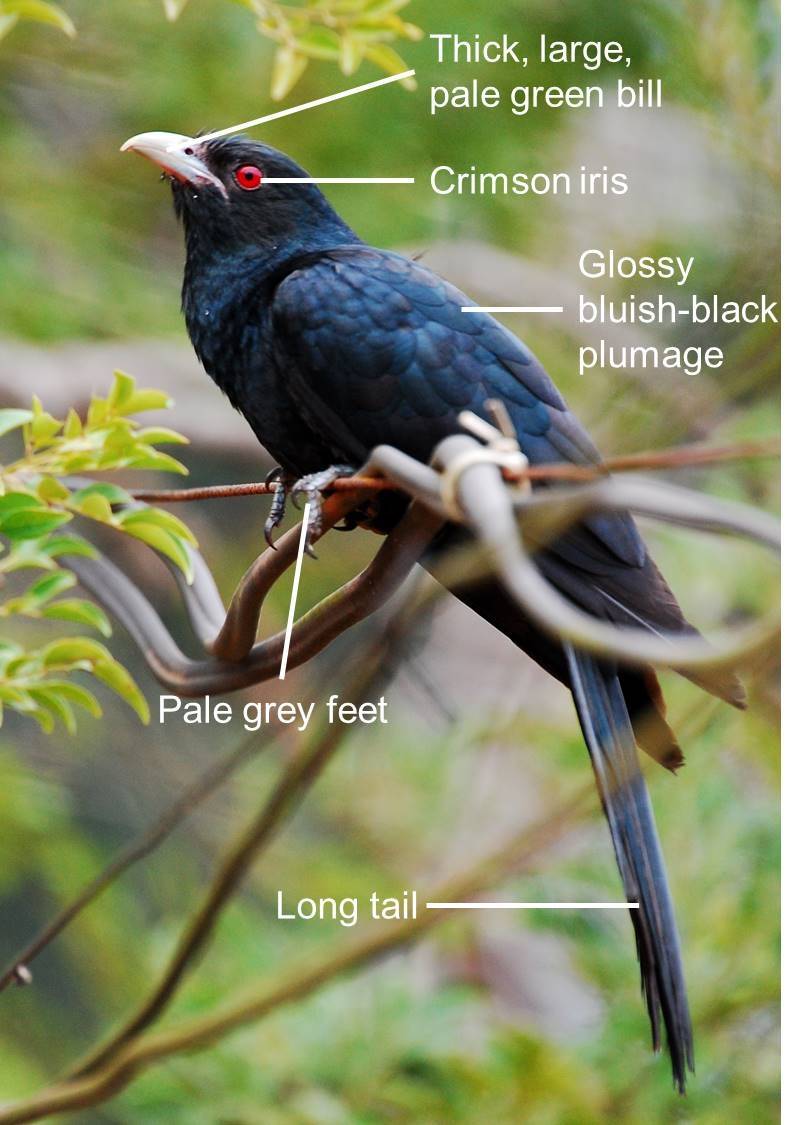
2.2 Female
Females have a dark brown crown with rufous streaks on the head. The back, rump and wing coverts are dark brown with creamy-white or rufous speckles. The underparts are cream to whitish, with fine dark brown bars. The tail is barred dark brown and creamy-white or rufous [3,5].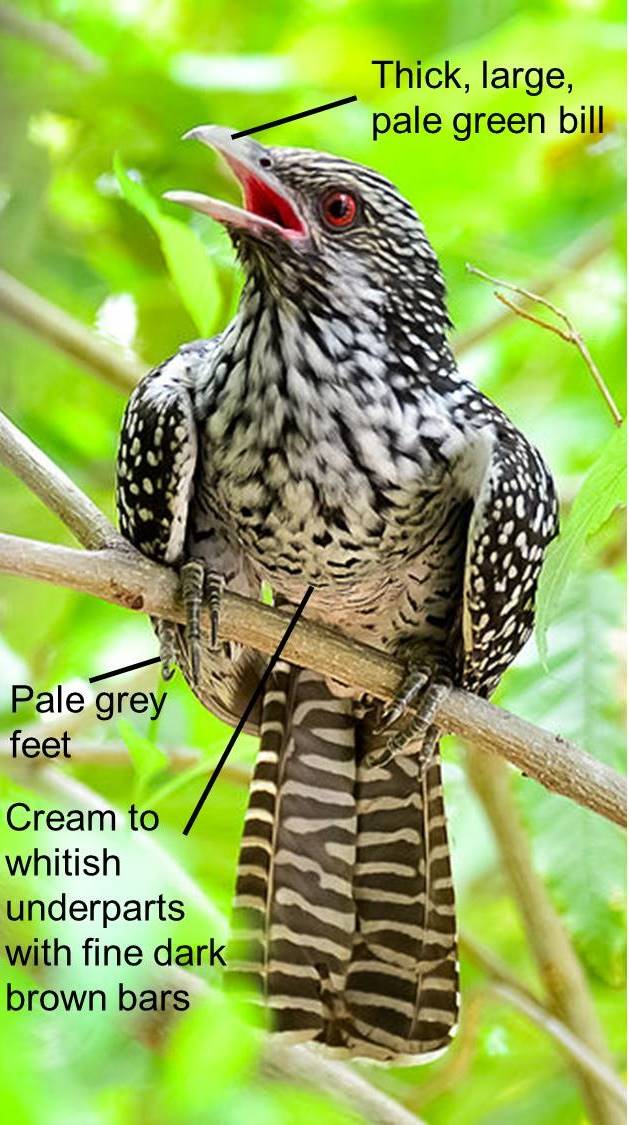 |
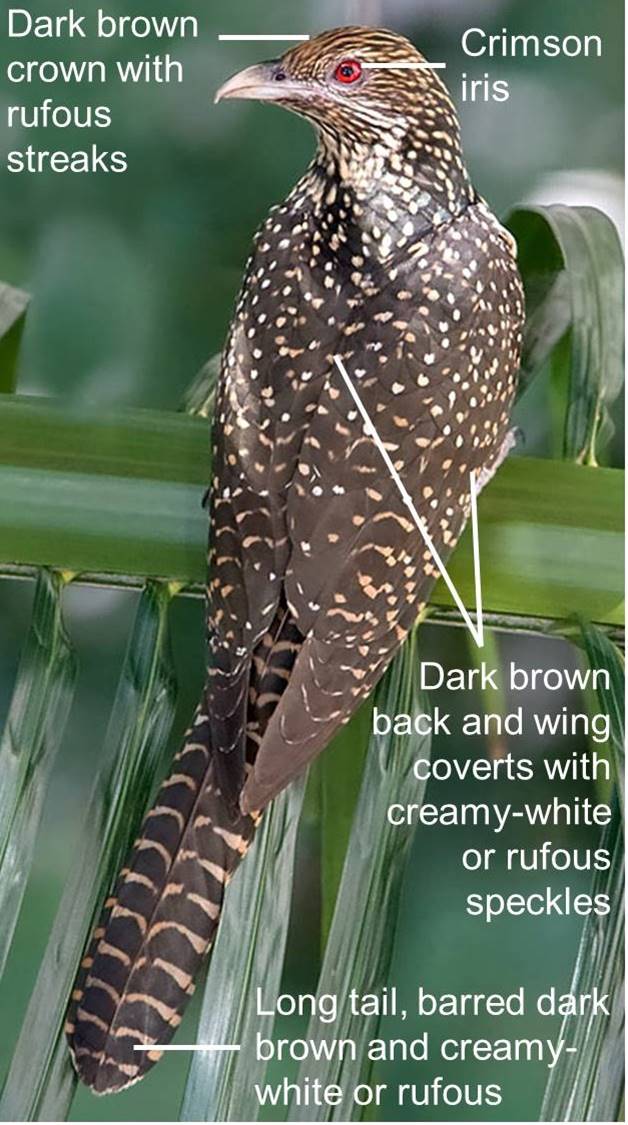 |
| Figure 4: Front view of Female Eudynamys scolopaceus with distinctive features. Adapted from K. Hari Krishnan, 2014 (Wikimedia Commons) |
Figure 5: Rear view of Female Eudynamys scolopaceus with distinctive features. Adapted from Doug Janson, 2008 (Wikimedia Commons) |
2.3 Juvenile
Juveniles are uniformly black after hatching, but moult quickly to resemble adult females. However, their irises are darker (Figure 6) [2].Young males often have coverts faded blackish-brown with white tips. The unmoulted wing feathers sometimes retain residual white barring, and paler tips to the edges of primaries and wing coverts (Figure 7) [2].
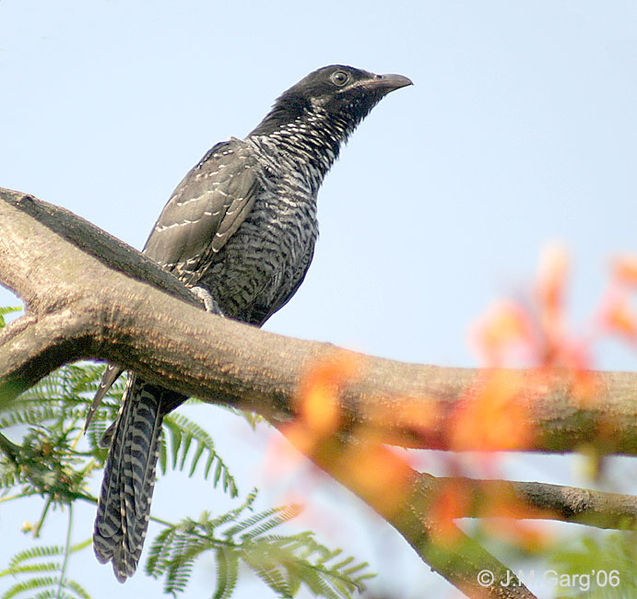 |
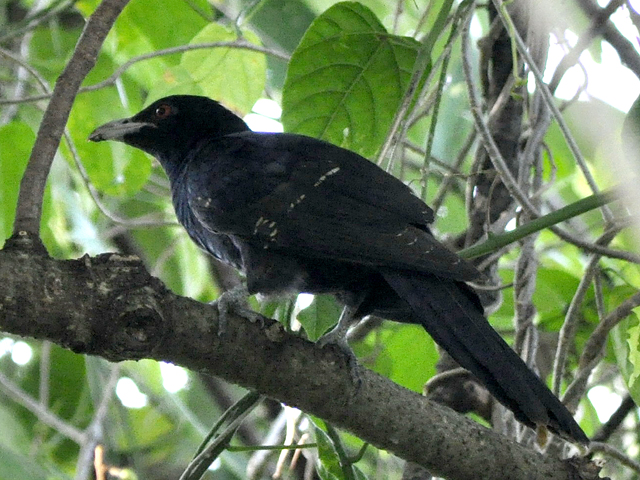 |
| Figure 6: Immature Eudynamys scolopaceus. Note the black crown and darker iris, with newer, moulted feathers resembling those of the adult female.Source: J. M. Garg, 2006 (Wikimedia Commons) |
Figure 7: Immature male Eudynamys scolopaceus. Note the darker iris and unmoulted wing feathers retaining residual white barring.Source: Amar-Singh H.S.S., 2011 (permission obtained) |
2.4 Diagnosis
While the female Eudynamys scolopaceus has diagnostic features, the male is often confused with other species of birds.Due to the similar size and plumage, it may be mistaken for a crow. In Singapore, there are two species of crows: the house crow (Corvus splendens) and the large-billed crow (Corvus macrorhynchos). Refer to Figures 3, 8, and 9 to distinguish the male E. scolopaceus from C. splendens and C. macrorhynchos [6].
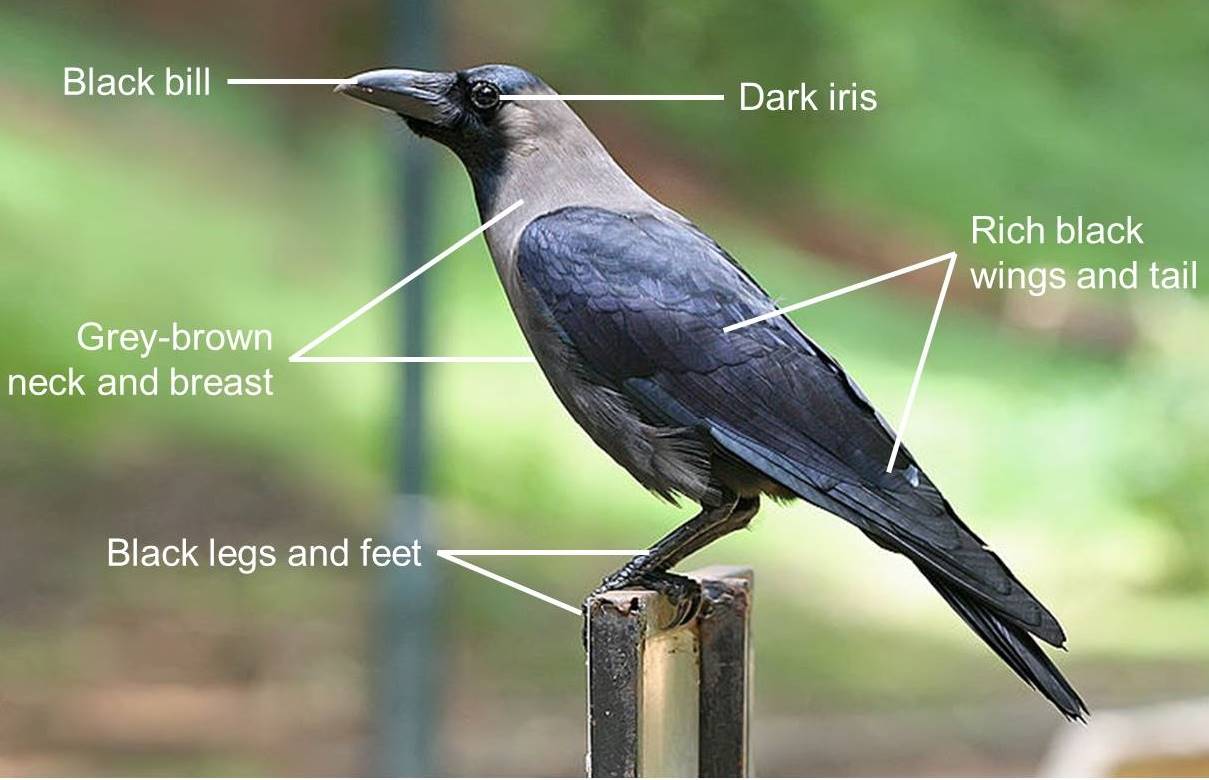 |
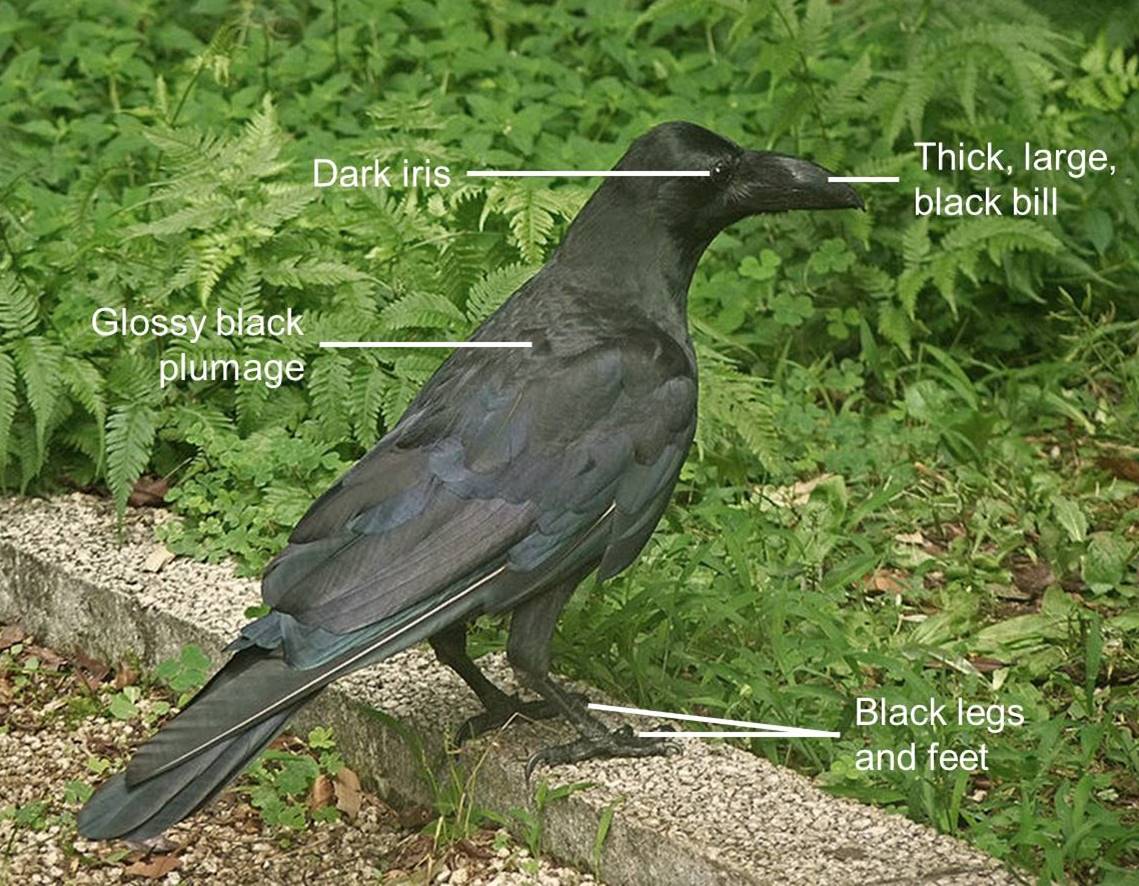 |
| Figure 8: House crow (Corvus splendens) with features shown. Adapted from Muhammad Mahdi Karim, 2009 (Wikimedia Commons) |
Figure 9: Large-billed crow (Corvus macrorhynchos) with features shown. Adapted from Francisco Restivo, 2010 (Wikimedia Commons) |
While the Asian glossy starling (Aplonis panayensis) has a similar plumage and red irises (Figure 10), it can be distinguished from the male E. scolopaceus by its much smaller size (20 cm from bill tip to tail tip) [7].
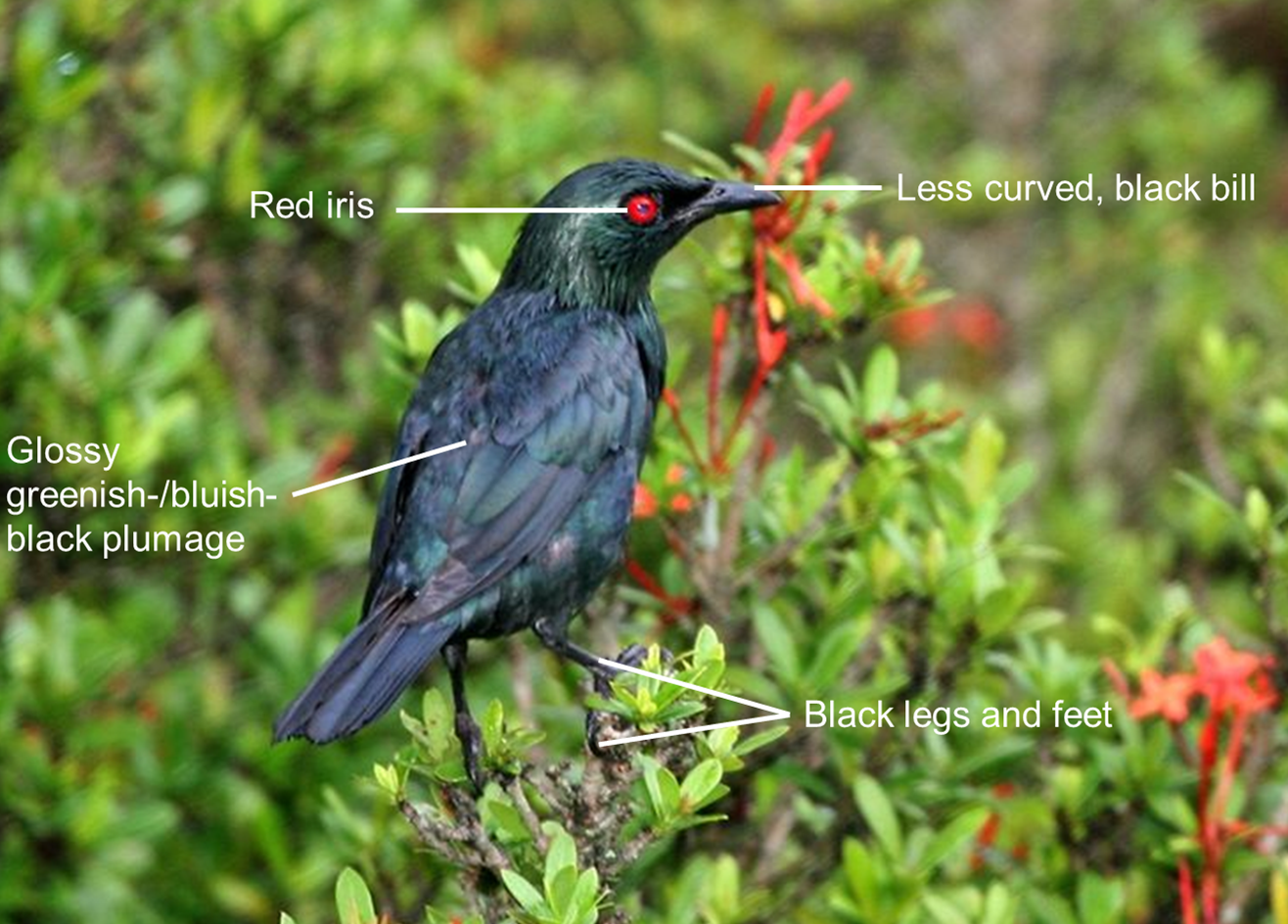
Table 1: Comparison of features among male Eudynamys scolopaceus, Corvus splendens, Corvus macrorhynchos, and Aplonis panayensis.
| Species |
Male Asian koel (Eudynamys scolopaceus) |
House crow (Corvus splendens) |
Large-billed crow (Corvus macrorhynchos) |
Asian glossy starling (Aplonis panayensis) |
| Length (bill tip to tail tip) |
39–46 cm |
40–43 cm |
46–59 cm |
20 cm |
| Colour of iris |
Crimson |
Dark brown or black |
Dark brown or black |
Red |
| Bill |
Thick, large, pale green |
More slender, black |
Thick, large, black |
Less curved, black |
| Plumage |
Glossy bluish-black |
Rich black, with grey-brown neck and breast |
Glossy black |
Glossy greenish-/bluish-black overall, matt black on vent |
| Colour of legs and feet |
Pale grey |
Black |
Black |
Black |
3 Ecology and behaviour
3.1 Vocalisation
The loud, unmistakable calls of Eudynamys scolopaceus can be heard throughout the day.
Calls produced by the males and females are different.
Calls produced by the males and females are different.
With its loud, distinct calls, Eudynamys scolopaceus is more often heard than seen. The calls can be heard throughout the day, even late at night, and especially early in the morning. It is especially vocal during breeding seasons.
The calls of males and females of this species differ and can be easily distinguished. The male produces a dissyllabic ‘koo-Ooo’ call, with emphasis on the second syllable. It is usually repeated several times, increasing in pitch and loudness with each successive call, then stopped abruptly [2,5]. This type of call can be used to proclaim its territory [2].
The male also produces a continuous excited ‘kwok-kwok-kwok’ call, which can be described as bubbly. However, this type of call has been observed to accompany aggressive behaviour among rival males [8].
The female makes a continuous and shrill ‘kik-kik-kik’ call.
Due to E. scolopaceus being a brood parasite (link to 3.4 breeding and reproduction), juveniles may learn to imitate the calls of their host parents’ young, though this is not always the case. Click here for a video of a juvenile female calling like a crow.
3.2 Habitat
Eudynamys scolopaceus can be found in both natural and man-made habitats.
Eudynamys scolopaceus resides in a variety of natural and man-made habitats, such as light woodland, mangroves, plantations, gardens, parks, and low-density urban areas. It is rarely found in forests, though it can be found around the fringes of secondary forests [9,10].
3.3 Diet and feeding habits
Adults mainly feed on fruits, but consume insects and eggs of small birds as well.
Adults are largely frugivorous, feeding on the fruits of plants like the Ceram palm (Rhopaloblaste ceramica), yellow oleander (Thevetia peruviana), and Indian sandalwood (Santalum album) [11,12]. Occasionally, they feed on insects and eggs of small birds as well [13]. They are shy, arboreal (tree-dwelling) birds, and usually do not venture out of the canopy to feed [14].
3.4 Breeding and reproduction
3.4.1 Brood parasitism
Eudynamys scolopaceus is a brood parasite*. Its hosts include crows and mynas.
Eudynamys scolopaceus is a brood parasite*, and parasitises a range of hosts, including the house crow (Corvus splendens), Javan myna (Acridotheres javanicus), common myna (Acridotheres tristis), and long-tailed shrike (Lanius schach). The black-naped oriole (Oriolus chinensis) is also a possible host [15,16].
In Singapore, this brood parasitism behaviour may provide ecological benefits in the form of house crow (C. splendens) population management (see Distribution in Singapore).The C. splendens population in Singapore had risen rapidly since 1985 and were seen as pests, prompting measures such as culling to curb the population growth [17]. Brood parasitism by E. scolopaceus could have lowered the C. splendens population further, but there has not been significant correlation between changes in E. scolopaceus and C. splendens populations [18].
* Brood parasites manipulate other individuals of the same species or another species (hosts) so that the host raises the young of the parasite. Cuckoos are the most well-known example, though this behaviour can be found in insects and fish as well.
3.4.2 Breeding season
The breeding season of Eudynamys scolopaceus typically corresponds to that of its usual host.
The breeding season of Eudynamys scolopaceus typically corresponds to that of its usual host. For example, if the usual host is the house crow (Corvus splendens), it will be roughly every three months, throughout the year [19,20].
3.4.3 Courtship
Courtship behaviour has not been well-studied.
However, males do call to proclaim their territory and display aggressiveness, and have been observed to offer food to females.
However, males do call to proclaim their territory and display aggressiveness, and have been observed to offer food to females.
Courtship behaviour in Eudynamys scolopaceus has not been well-studied. However, it is known that the ‘koo-Ooo’ call is used by males to proclaim their territory, and that rival males confront one another with increasing aggressiveness by flapping their wings and fanning their tails, along with loud ‘kwok-kwok-kwok’ calls [8]. These behaviours may better the chances of males securing mates.
Courtship feeding, in which the male feeds the female with fruits or insects, has been observed in India, Australia, and more recently in Singapore [21,22,23,24].
3.4.4 Egg laying and parental care
The female sneaks into a host’s nest to lay its egg while the male distracts the host.
The egg usually hatches before the host’s eggs, and the chick may mimic begging calls of the host’s chicks to secure parental care.
The egg usually hatches before the host’s eggs, and the chick may mimic begging calls of the host’s chicks to secure parental care.
The female Eudynamys scolopaceus can lay several eggs per breeding cycle, usually laying an egg in each nest she visits, after the host has laid its first egg [19,25].
To allow the female to approach the host’s nest to lay its egg, the male calls loudly close to the nest to advertise its presence, tempting the hosts to give chase. Meanwhile, the female conceals itself nearby. After the hosts are lured far enough, it slips into the nest to lay its egg swiftly [2]. It is unclear whether the hosts’ eggs are destroyed by the female.
The eggs of E. scolopaceus, although slightly smaller, resemble crow eggs. They can vary from pale greenish-yellow to greyish-green, with reddish-brown speckles and blotches [26]. Therefore, coevolution* of E. scolopaceus and its hosts may have resulted in these eggs matching the eggs of the hosts.
Given that E. scolopaceus eggs have a shorter incubation period than crow eggs (13–14 days compared to 16–20 days), E. scolopaceus tend to hatch first, and the hatchlings could possibly evict host eggs or chicks from the nest [25].
After a nesting period of 19–28 days, E. scolopaceus fledglings continue to be fed by their foster parents for another two to three weeks [25]. Although they may mimic the begging call of the hosts’ young , it is not always the case. Therefore, it is possible that female E. scolopaceus do feed their young [25], if there is a lack of parental care by the host parents due to the chicks being unable to mimic such calls. However, this claim has not been supported.
Video of Corvus splendens foster parents feeding Eudynamys scolopaceus chicks:
* Coevolution is used to describe cases where two (or more) species influence each other's evolution.
4 Distribution
4.1 Global
Eudynamys scolopaceus can be found in many parts of Asia, ranging from Pakistan to Indonesia.
Eudynamys scolopaceus resides in much of Asia, ranging from Pakistan to Indonesia. Some populations are vagrant, migrating to warmer regions during winter. Refer to Figure 11 for the global distribution of E. scolopaceus [27].
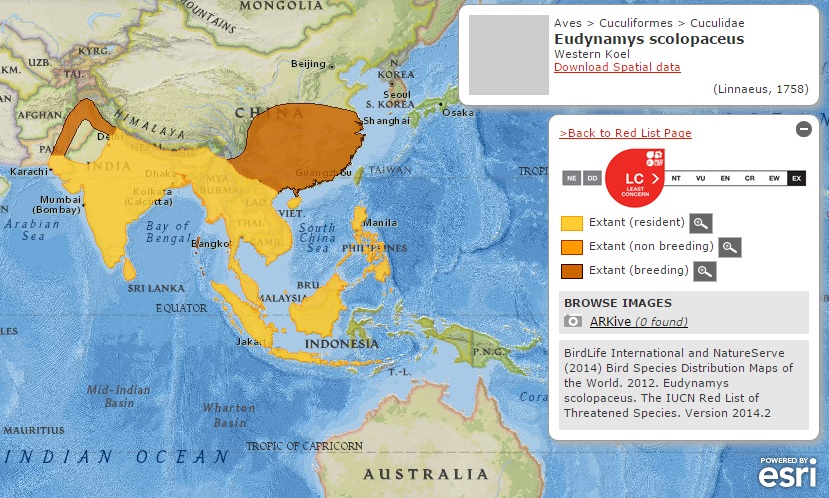
4.2 Singapore
In 2009, Eudynamys scolopaceus was the 20th most common bird in Singapore.
Its success may be attributed to the growing house crow (Corvus splendens) population from the 1980s to 2003.
Its success may be attributed to the growing house crow (Corvus splendens) population from the 1980s to 2003.
The population of Eudynamys scolopaceusin Singapore has not been determined, but the 24th Annual Bird Census conducted by the Nature Society (Singapore) in 2009 found it to be the 20th most numerous avian species in Singapore [28].
The breeding population of E. scolopaceus has become widespread since 1987 [25]. This was perhaps aided by the escalating house crow (Corvus splendens) population. After population management strategies implemented in 2003 caused the C. splendens population to be greatly reduced, it is believed that E. scolopaceus continued to thrive by turning towards other host species, such as the Javan myna (Acridotheres javanicus), the most common avian species in Singapore [16,28]. In addition, the now more scattered C. splendens population results in increased vulnerability to brood parasitism by E. scolopaceus, since nesting in groups could lower the occurrence of brood parasitism [16].
The proliferation of E. scolopaceus in Singapore has led to some residents’ unhappiness over their loud calls, while others are more tolerant of them. Read about the different opinions at the following links: link 1, link 2, link 3, link 4.
5 Conservation status
Globally, Eudynamys scolopaceus is a species of least concern, but it is a protected species in Singapore.
Conservation status: least concern (IUCN 3.1) [27]
Although the population of Eudynamys scolopaceus is not known, it occupies a large range globally, and its population trend appears to be stable [27]. Being able to survive in some urban areas (see Habitat), urbanisation does not appear to pose much of a threat to it.
In Singapore, E. scolopaceus is a species protected under the Wild Animals and Birds Act, and is not listed under the Schedule.
6 Taxonomy and systematics
6.1 Taxonavigation
Eudynamys scolopaceus was originally known as Cuculus scolopaceus until 1827.
Table 2 provides a hierarchical summary of clade names in the taxonomic classification of Eudynamys scolopaceus.
Table 2: Taxonavigation of Eudynamys scolopaceus.
| Animalia |
| Chordata |
| Aves |
| Cuculiformes |
| Cuculidae |
| Eudynamys |
| E. scolopaceus (Linnaeus, 1758) |
E. scolopaceus was originally described by Linnaeus as Cuculus scolopaceus based on a specimen he received from the Malabar region [29]. It was later moved to the new genus Eudynamys by Vigors and Horsfield in 1827 as it has a relatively more powerful bill and stronger tarsi and feet than true Cuculus cuckoos [29].
6.2 Phylogeny
The evolutionary history of Eudynamys scolopaceus is still unclear.
There has been much uncertainty on the phylogeny of taxa in Aves. Mayr (2008) collated the genetic and morphological information from previous studies to produce the following trees in Figure 12 [30]. The Tree of Life Web Project offers a comprehensive explanation on interpreting tree diagrams.
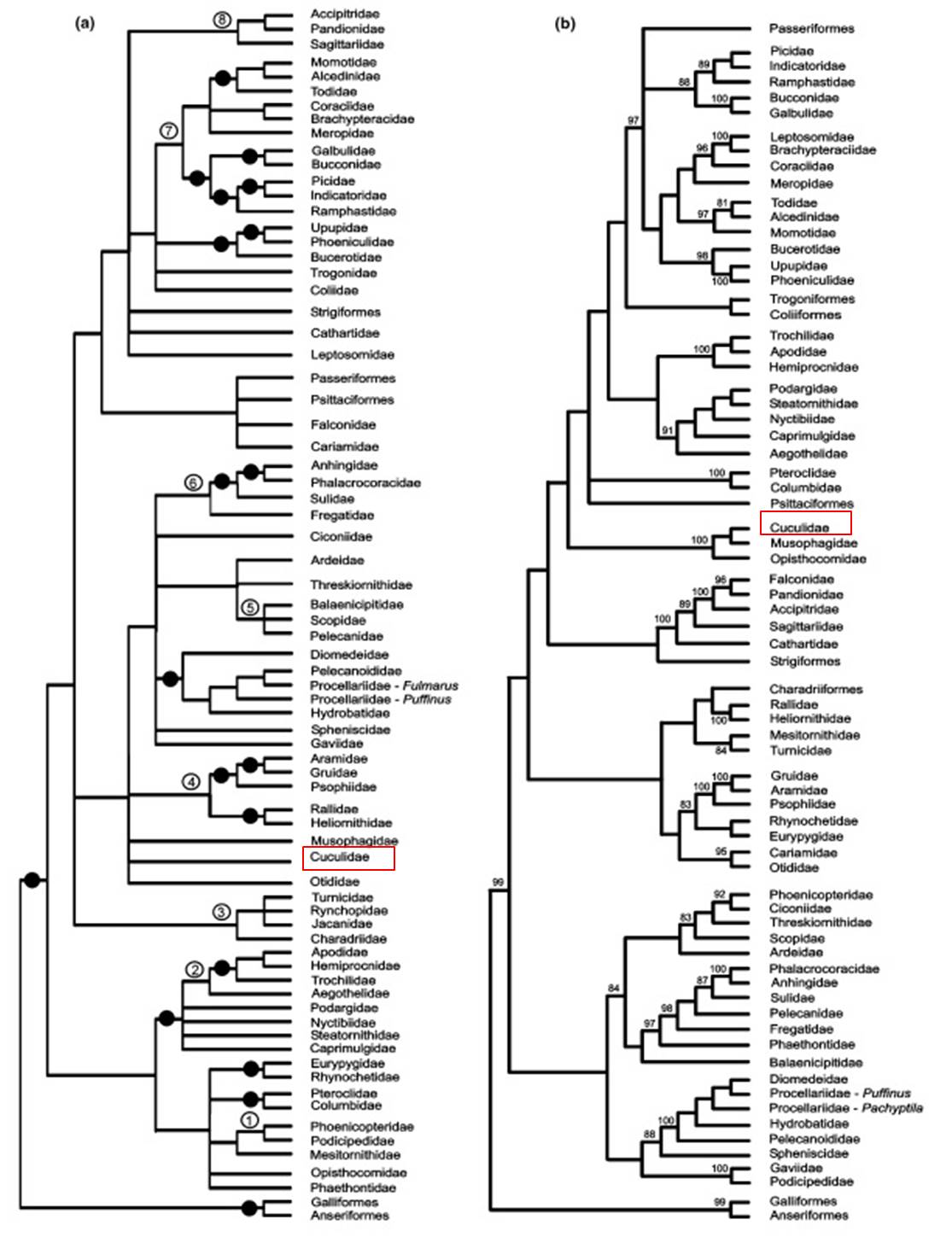
Figure 12: Phylogeny of Cuculidae among Neognathous birds derived from (a) a Bayesian analysis of five nuclear genes (β-fibrinogen, c-myc, RAG-1, myoglobin, and ornithine decarboxylase) and (b) a parsimony analysis of 2954 morphological characters. Nodes with posterior probability below 95% were collapsed in (a), while only bootstrap support values above 80% were shown in (b). Source: Mayr, 2008 (permission pending)
Phylogeny within Cuculidae has also been unclear. The Tree of Life Web Project displays the following tree for the subfamily Cuculinae, consisting of Old World parasitic cuckoos (Figure 13) [31].
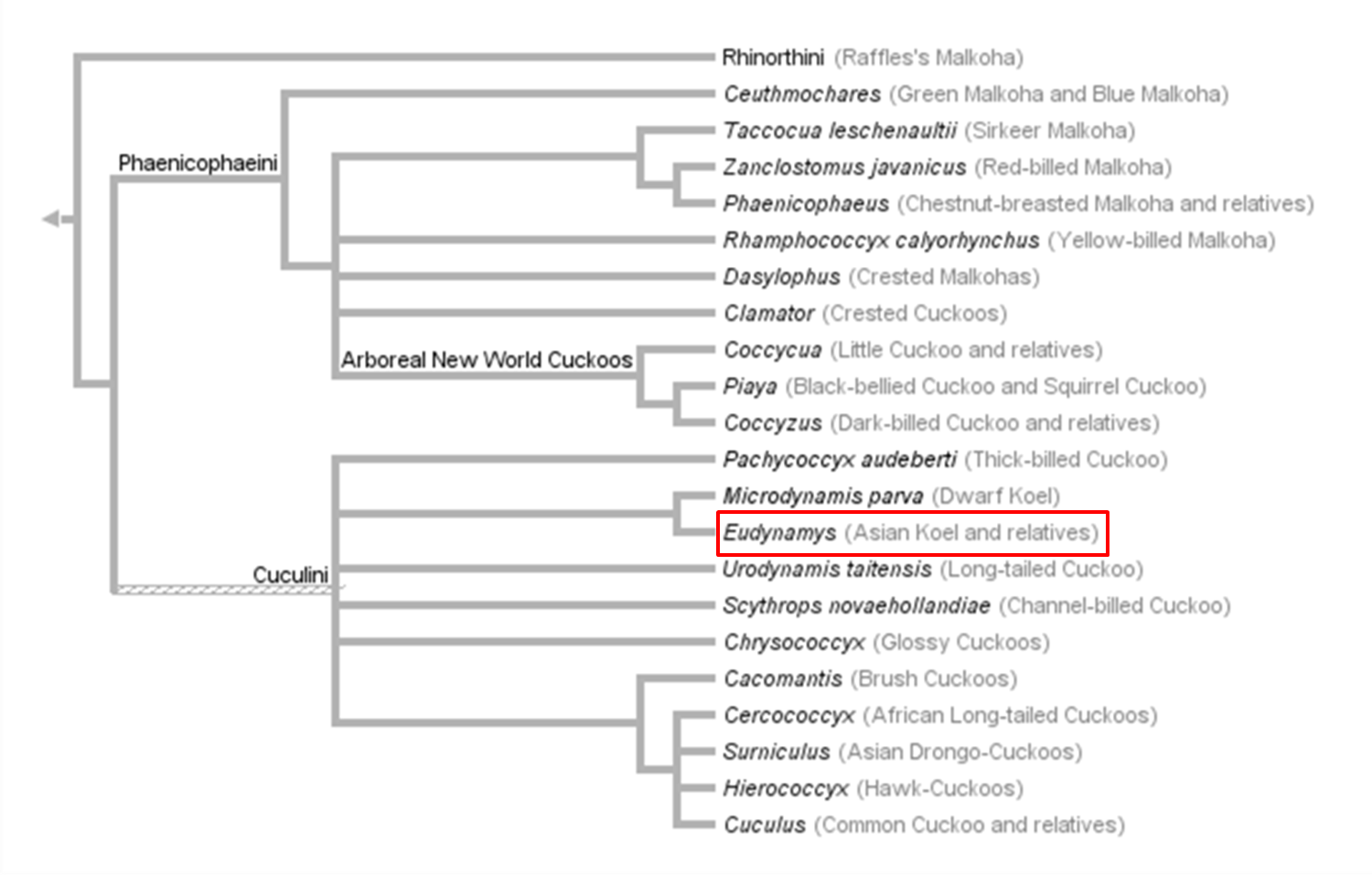
With respect to 135 osteological characters, Hughes (2000) placed Eudynamys as a sister taxon to Urodynamis (Figure 14) [32]. This classification was shown to support the evolution of brood parasitism in a single event instead of three events as previously proposed, as all brood parasitic cuckoos formed a clade [32].
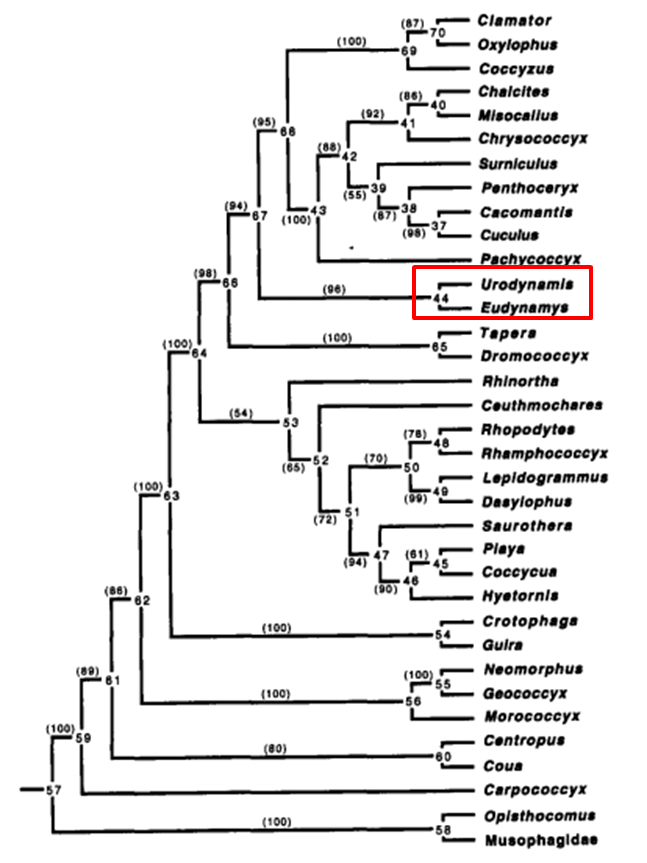
6.3 Variations in taxonomic classification
There are 18 species and subspecies identified, but this has not been agreed upon.
Some believe they should all be considered one species, while others cluster the species and subspecies to varying degrees.
Some believe they should all be considered one species, while others cluster the species and subspecies to varying degrees.
Eudynamys scolopaceus displays variations across its geographical range, with several island populations established. Some consider the black-billed koel (E. melanorhynchus) and Pacific koel (E. orientalis) conspecific with E. scolopaceus. In this case, the “combined” species E. scolopaceus is known as the common koel. Another way of classification is to consider E. melanorhynchus as a separate species, with E. scolopaceus encompassing E. orientalis and all its subspecies, with the exception of the Australian koel (E. cyanocephalus). Alternatively, the three are considered separate species, owing to differences in plumage, bill colour, and vocalisations. The last view is becoming increasingly accepted [23].
According to the 2012 Clements Checklist of Birds of the World, a regularly updated checklist maintained by the Cornell Lab of Ornithology, 18 species and subspecies have been identified [1]. A summary is provided in Table 3.
Table 3: Species and subspecies recognised by the 2012 Clements Checklist, with their respective geographical range.
| Species |
Subspecies |
Authority |
Geographical range |
| Eudynamys scolopaceus |
(Linnaeus, 1758) |
Tropical southern Asia to south China and Greater Sundas |
|
| Eudynamys scolopaceus scolopaceus |
(Linnaeus, 1758) |
Nepal to Pakistan, India, Sri Lanka, Laccadives and Maldives |
|
| Eudynamys scolopaceus chinensis |
Cabanis & Heine, 1863 |
Southern China and Indochina; winters to Borneo |
|
| Eudynamys scolopaceus harterti |
Ingram, 1912 |
Hainan (Southern China) |
|
| Eudynamys scolopaceus malayanus |
Cabanis & Heine, 1863 |
Northeast India to Thailand, Malaya, Sumatra, Borneo and Lesser Sundas |
|
| Eudynamys scolopaceus simalurensis |
Simeulue, Indonesia (off West Sumatra) |
||
| Eudynamys scolopaceus mindanensis |
(Linnaeus, 1766) |
Philippines, Palawan, Sulu Archipelago, Sangihe, Indonesia and Talaud Islands |
|
| Eudynamys scolopaceus corvinus |
North Moluccas (Morotai, Halmahera, Ternate, Tidore and Bacan) |
||
| Eudynamys scolopaceus frater |
Northern Philippines (Calayan and Fuga) |
||
| Eudynamys orientalis |
(Linnaeus, 1766) |
South Moluccas (Buru, Manipa, Kelang, Seram, Ambon, Watubela) |
|
| Eudynamys orientalis orientalis |
(Linnaeus, 1766) |
South Moluccas (Buru, Manipa, Kelang, Seram, Ambon, Watubela) |
|
| Eudynamys orientalis [rufiventer or minimus] |
(Lesson, 1830) |
New Guinea |
|
| Eudynamys orientalis salvadorii |
Hartert, 1900 |
Bismarck Archipelago |
|
| Eudynamys orientalis alberti |
Rothschild & Hartert, 1907 |
Solomon Islands |
|
| Eudynamys orientalis picatus |
Müller, 1843 |
Kai Islands and Sumba to Timor and Roma |
|
| Eudynamys cyanocephalus |
Australia |
||
| Eudynamys cyanocephalus cyanocephalus |
(Latham, 1801) |
Northern Queensland to Southern New South Wales; winters to Moluccas |
|
| Eudynamys cyanocephalus subcyanocephalus |
Matthews, 1912 |
Northwest Australia to Northwest Queensland; winters to South Moluccas |
|
| Eudynamys melanorhynchus |
Müller, 1843 |
Sulawesi, Sula Islands |
|
| Eudynamys melanorhynchus melanorhynchus |
Sulawesi |
||
| Eudynamys melanorhynchus facialis |
Sula Islands |
Figure 15 shows the distribution of four E. scolopaceus subspecies: E. s. chinensis, E. s. malayanus, E. s. mindanensis, and E. s. scolopaceus.
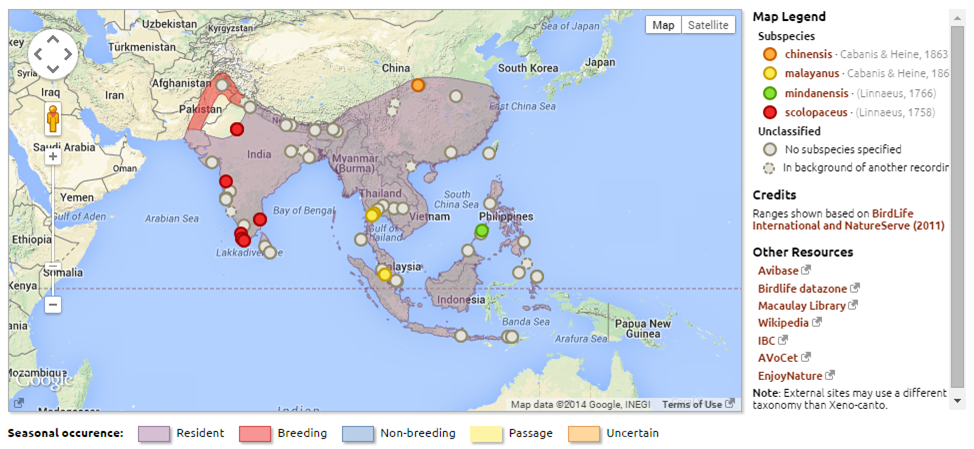
Figure 15: Geographical distribution of Eudynamys scolopaceus chinensis, E. s. malayanus, E. s. mindanensis, and E. s. scolopaceus. Source: xeno-canto, 2014 (permission pending)
7 Biogeography
A study by Posso and Donatelli (2012) found that cuckoos that live in trees (arboreal) originated in South America, then spread to other continents.
Using the Principle of Parsimony based on primary and secondary “Brooks Parsimony Analysis” (BPA), Posso and Donatelli (2012) proposed that arboreal cuckoos originated in South America, and dispersed to inhabit other continents thereafter (Figure 17) [33]. This is because Coccyzus, the most basal genus in Cuculinae, is found in South America [33].
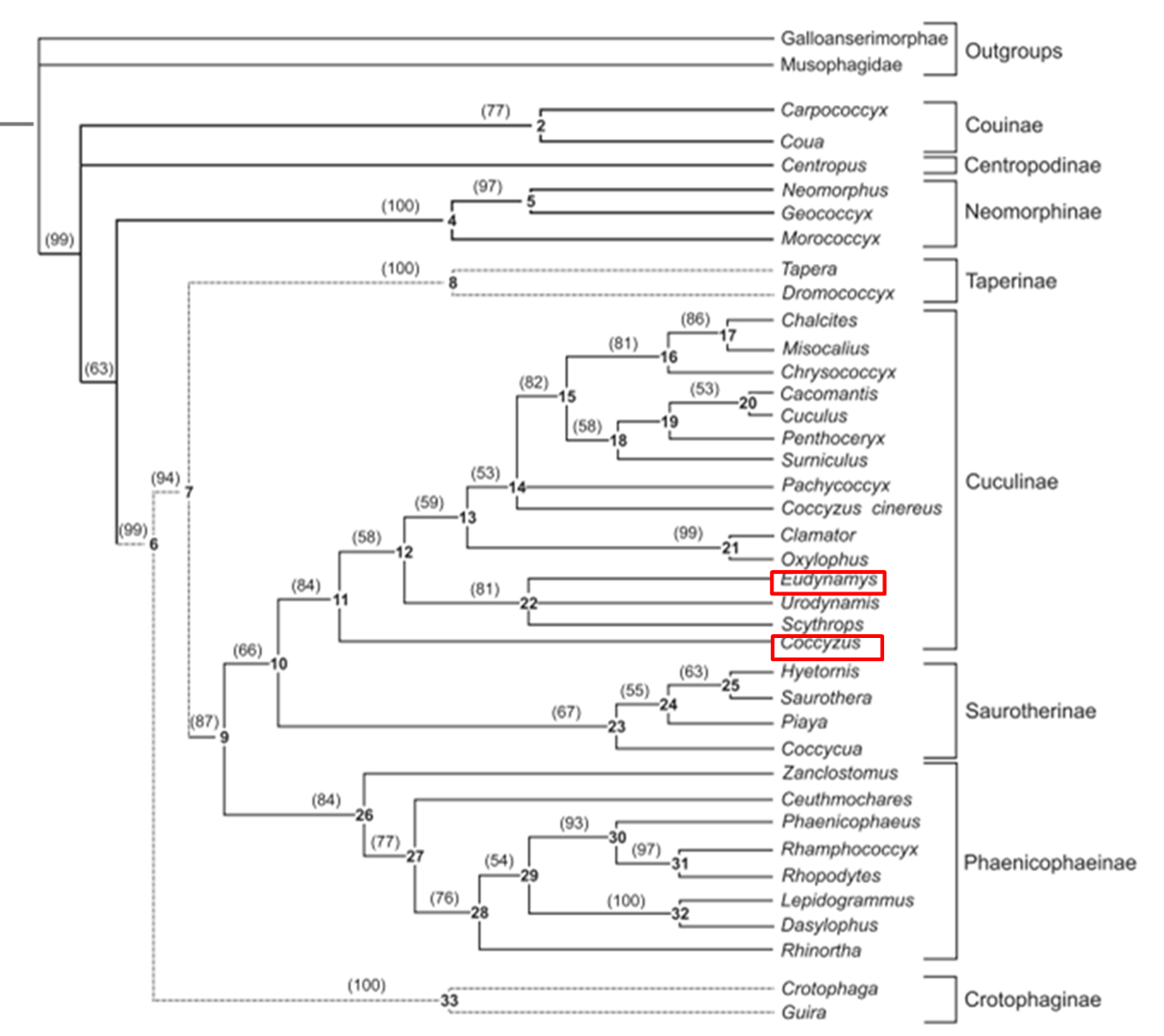
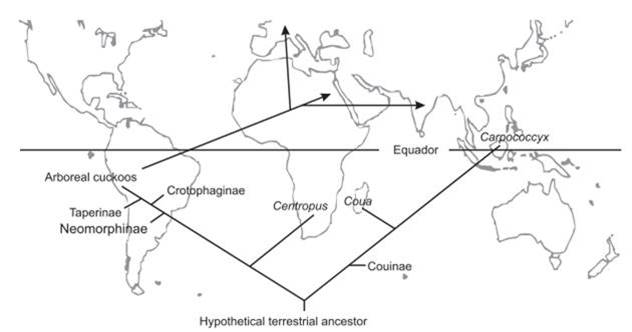
8 Molecular data
GenBank is an open access database containing all publicly available nucleotide sequences and their protein translations.
It does not contain the full genome of Eudynamys scolopaceus, but a few of the genes can be found there.
It does not contain the full genome of Eudynamys scolopaceus, but a few of the genes can be found there.
The database GenBank contains the sequences of genes such as cytochrome oxidase subunit I (COI), cytochrome b (cytb), and NADH dehydrogenase subunit 2 (ND2), although the full genome of Eudynamys scolopaceus has not been sequenced.
9 References
[1] Avibase, 2014. Eudynamys [scolopaceus, orientalis, cyanocephalus or melanorhynchus]. Avibase. Retrieved 11 November 2014, from http://avibase.bsc-eoc.org/species.jsp?avibaseid=5D43995351C97BC6[2] Bird Ecology Study Group, 2011. Birds of Singapore: Asian Koel (Eudynamys scolopacea). The Birds of Singapore. Retrieved 11 November 2014, from http://singaporebirds.net/npassers_01/asian_koel.html
[3] Oiseaux-Birds, n.d. Asian Koel. Oiseaux-Birds. Retrieved 11 November 2014, from http://www.oiseaux-birds.com/card-asian-koel.html
[4] Dunning, J. B. Jr., 1992. CRC Handbook of Avian Body Masses. CRC Press. ISBN 978-0-8493-4258-5.
[5] Encyclopaedia of Life, n.d. Descriptions and Articles about the Common Koel (Eudynamys scolopaceus). Encyclopaedia of Life. Retrieved 11 November 2014, from http://eol.org/pages/1064881/details#cite_note-payne-10
[6] Singapore Birds, 2012. Crows. Singapore Birds. Retrieved 11 November 2014, from http://singaporebirds.blogspot.sg/2012/06/crows.html
[7] Oiseaux-Birds, n.d. Asian Glossy Starling.Oiseaux-Birds. Retrieved 22 November 2014, from http://www.oiseaux-birds.com/card-asian-glossy-starling.html
[8] Wee, Y. C., 2007. Koel Confrontation. Bird Ecology Study Group. Retrieved 11 November 2014, from http://www.besgroup.org/2007/03/21/koel-confrontation/
[9] BirdForum, 2014. Asian Koel. BirdForum. Retrieved 11 November 2014, from http://www.birdforum.net/opus/Asian_Koel
[10] The Birds of NUS, 2012. Asian Koel. The Birds of NUS. Retrieved 11 November 2014, from http://nusavifauna.wordpress.com/2012/07/25/asian-koel/
[11] Hegde, S. G., Uma Shaanker, R. & Ganeshaiah, K. N., 1991. Evolution of seed size in the bird-dispersed tree Santalum album L.: a trade-off between seedling establishment and dispersal efficiency. Evol. Trends. Plants 5: 131–135.
[12] Krishnan, M., 1952. Koels (Eudynamis scolopaceus) eating the poisonous fruit of the Yellow Oleander. J. Bombay Nat. Hist. Soc. 50: 943–945.
[13] Ali, S. & Ripley, D.S., 1969. Handbook of the Birds of India and Pakistan. Vol. 3. Oxford University Press, London. 380 pp.
[14] Roberts, T. J., 1991. The Birds of Pakistan Vol. 1. Oxford University Press, Karachi. 666 pp.
[15] Lowther, P. E., 2011. Host List of Avian Brood Parasites. Retrieved 11 November 2014, from http://www.fieldmuseum.org/sites/default/files/Cuckoo-12Sep2011.pdf
[16] Begum, S., Moksnes, A., Røskaft, E. & Stokke, B. G., 2011. Factors influencing host nest use by the brood parasitic Asian Koel (Eudynamys scolopacea). J. Ornithol 152: 793–800.
[17] Brook, B.W., Sodhi, N.S., Soh, M.C.K. & Lim, H.C., 2003. Abundance and projected control of invasive house crows in Singapore. J. Wildl. Manage. 67: 808–817.
[18] Chong, K. Y., Teo, S., Kurukulasuriya, B., Chung, Y. F., Rajathurai, S., Lim, H. C. & Tan, H. T. W., 2012. Decadal changes in urban bird abundance in Singapore. Raffles. B. Zool. 25: 189–196.
[19] Jerdon, T.C., 1862. The Birds of India: A Natural History, Vol. 1. The Military Orphan Press, Calcutta.
[20] AVA, n.d. Advisory on Asian Koels. Retrieved 11 November 2014, from http://www.ava.gov.sg/NR/rdonlyres/BACEEC21-2D82-40D3-AB42-76F65262D890/27022/Advisoryonasiankoels.pdf
[21] Tan, S., 2010. Courtship feeding in Asian koel. Bird Ecology Study Group. Retrieved 11 November 2014, from http://www.besgroup.org/2010/02/19/courtship-feeding-in-asian-koel/
[22] Higgins, P. J. (ed.), 1999. Handbook of Australian, New Zealand and Antarctic birds. Vol. 4, Parrots to dollarbirds. Oxford University Press, London.
[23] Lamba, B. S., 1969. The nidification of some common Indian birds – part 12. J. Bombay Nat. Hist. Soc. 66: 72-80.
[24] Finn, F., 1917. The Birds of Calcutta. Thacker, Spink & Co., Calcutta. 136 pp.
[25] Payne, R. B., 2005. The Cuckoos. Oxford University Press, New York. 644 pp.
[26] Baker, E. C. S., 1927. Fauna of British India: Birds. Vol. 4. Taylor & Francis, London.
[27] BirdLife International, 2012. Eudynamys scolopaceus. The IUCN Red List of Threatened Species. Version 2014.2IUCN. Retrieved 11 November 2014, from http://www.iucnredlist.org/details/22684049/0
[28] Lim, K. S., 2009. Report on the 24th Annual Bird Census. Retrieved 11 November 2014, from http://wildbirdsingapore.nss.org.sg/2009ABC.pdf
[29] Long, G. (ed.), 1833. The Penny Cyclopaedia of the Society for the Diffusion of Useful Knowledge. Vol. 8. Charles Knight, London.
[30] Mayr, G., 2008. Avian higher-level phylogeny: well-supported clades and what we can learn from a phylogenetic analysis of 2954 morphological characters. J Zool Syst Evol Res 46: 63–72.
[31] Tree of Life Web Project, 2007. Cuculinae. Tree of Life Web Project. Retrieved 11 November 2014, from http://tolweb.org/Cuculinae/103814
[32] Hughes, J. M., 2000. Monophyly and phylogeny of cuckoos (Aves, Cuculidae) inferred from osteological characters. Zool. J. Linn. Soc. 130: 263–307.
[33] Posso, S. R. & Donatelli, R. J., 2012. Biogeography on the early distribution of cuckoos (Aves: Cuculiformes). Zoologia 29: 187–194.